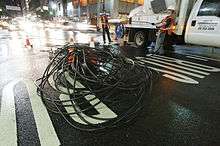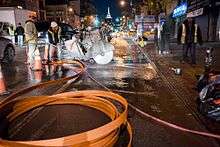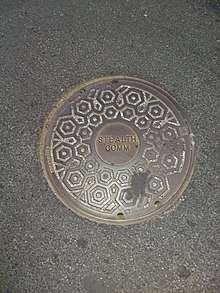Stealth Communications
Stealth Communications is an American fiber-based Internet service provider (ISP), installing and maintaining its own fiber optic network throughout New York City. Stealth began rolling out its Gigabit Internet services in late 2013 to businesses throughout Manhattan, using in-house employees to lay its own fiber-optic cabling.[4] In July 2015, City of New York and Stealth announced a $5.3 million public/private partnership to expand fiber broadband into Brooklyn and Queen's Industrial Business Zones.[5][6] As of May 2019, the company reported to have connected hundreds commercial properties with fiber, over 73 fiber route miles.[7][8]
 | |
| Private | |
| Industry | Internet & communications |
| Founded | 1995 |
| Headquarters | New York City |
Area served | New York City |
Key people | Shrihari Pandit and Jinci Liu (Co founders).[1] |
| Products | Fiber-based Gigabit Internet services Dark fibre |
| Website | www |
| Primary ASN | 8002 |
|---|---|
| Traffic Levels | >1 Tbps[2] [3] |
Overview
Stealth Communications started in 1995 to provide ultrafast Internet connectivity to businesses in NYC.[9] In 2013 the company received authorization from the City of New York to construct its own fiber network.[1][10]
Technology
Fiber distribution
Stealth utilizes an underground conduit system for placing its fiber-optic cables, that is owned and maintained by Empire City Subway.[11] Once their fiber-optic cable reaches the closest manhole to the building, Stealth pulls the fiber-optic cable through existing conduits or builds a new conduit into the building.[12] In certain cases due to the conditions of the conduit system, conduits are clogged or collapsed often causing costly re-routing by lengthy distances and construction of entirely new conduits.[13][14][15]



Fiber technology
Stealth implements WDM fiber transmission technology for connecting customers to its hubs, by allocating a wavelength for each customer, whereas each wavelength is capable of transmitting between 1 Gbit/s to 100 Gbit/s.[11] The company claims that it makes use of special materials to split and combine multiple wavelengths running through the fiber-optic cables without requiring electricity.[11]
References
- Messina, Judith (2014-02-13). "David versus the broadband Goliaths". Crains New York. Retrieved 18 February 2014.
- "Stealth Communications Continues its Massive NYC Fiber Expansion".
- "PeeringDB". PeeringDB.
- Neubauer, Miranda (17 October 2014). "In Harlem, officials and industry seek broadband momentum". Politico. Retrieved 1 July 2015.
- "Digital deserts' of Brooklyn, Queens to get broadband boost". Bizjournals.com. Retrieved 4 February 2016.
- Flamm, Matthew. "City will bring high-speed broadband to digital deserts in Brooklyn and Queens". Crains New York. Retrieved 1 July 2015.
- Powell, Rob. "Metro Fiber and On-Net Buildings List". Telecom Ramblings. Retrieved 24 December 2015.
- "Stealth continues its massive NYC fiber expansion". CISION PR Newswire. Retrieved 14 May 2019.
- Jeffres, Michelle; Lajoie, Scott (5 October 1998). "Who Makes What". Forbes. Retrieved 4 February 2016.
- "Tech Tenants Want Office Buildings With Multiple Broadband Providers". Observer.com. Retrieved 4 February 2016.
- "New York City Awards Fiber-Optic Networks to Some Businesses". GOVERNING. 9 April 2014. Retrieved 21 January 2016.
- Dale, Brady (20 May 2015). "Silicon Bowery: Does the Bowery Own the Future of Manhattan Creatives?". Commercial Observer. Retrieved 21 January 2016.
- Flamm, Matthew (13 May 2014). "Crossed Wires: Untangling NYC's broadband underground". Crains New York. Retrieved 21 January 2016.
- Google (13 May 2014). "Clogged arteries: NYC's fiber mess" (Map). Google Maps. Google. Retrieved 22 January 2016.
- "Ten Gbps Broadband Service Coming to Southwest Brooklyn". Observer.com. 2015-07-29. Retrieved 4 February 2016.